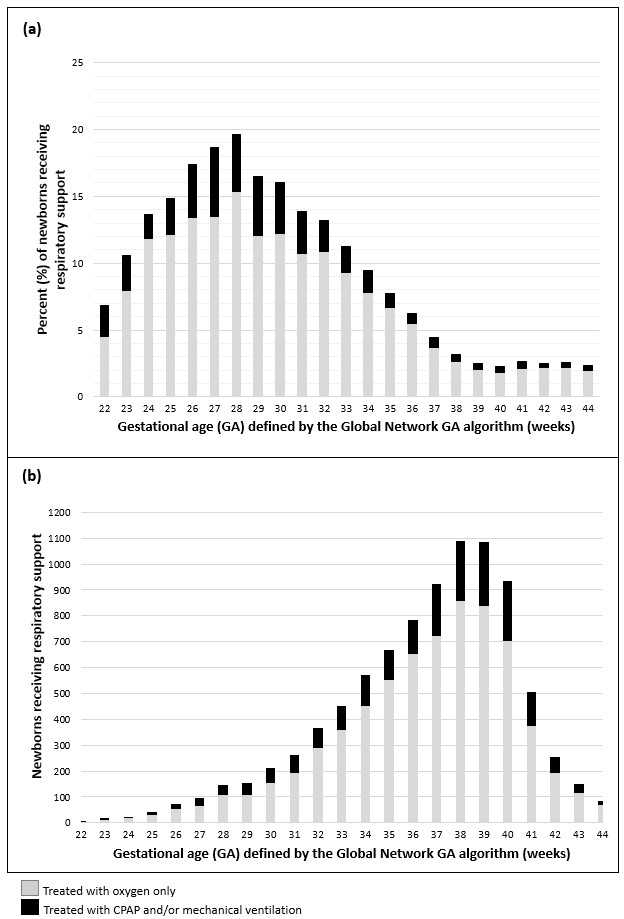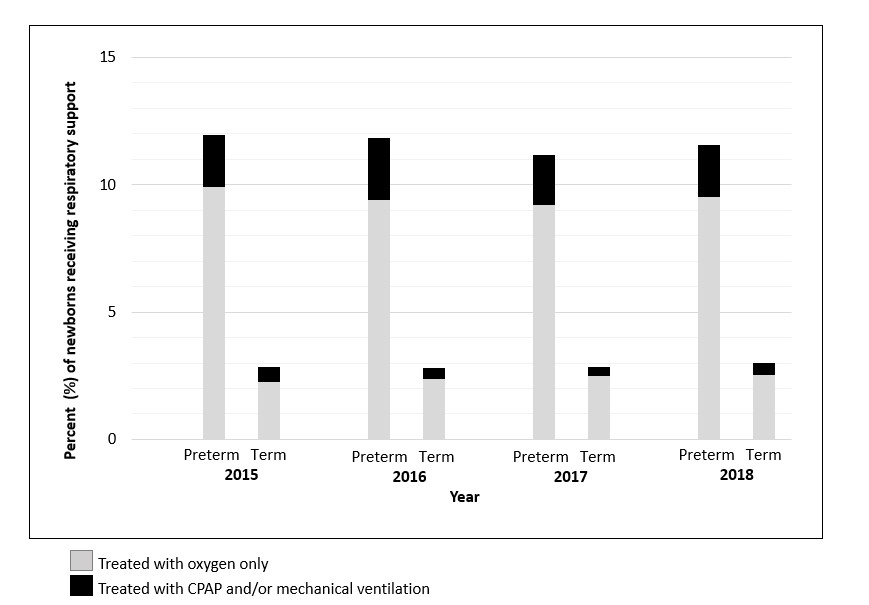Global Neonatal & Children's Health
Category: Abstract Submission
Global Child and Adolescent Health I
145 - Neonatal Respiratory Support Utilization in Low- and Middle-income Countries: A Population-based Study
Friday, April 22, 2022
6:15 PM - 8:45 PM US MT
Poster Number: 145
Publication Number: 145.111
Publication Number: 145.111
Nora Switchenko, University of Alabama at Birmingham, Homewood, AL, United States; Vivek V. Shukla, University of Alabama at Birmingham, Birmingham, AL, United States; Musaku Mwenechanya, UNIVERSITY TEACHING HOSPITAL, CHILDREN'S HOSPITAL, LUSAKU, Lusaka, Zambia; Patricia Hibberd, Boston University School of Public Health, Boston, MA, United States; Namasivayam Ambalavanan, University of Alabama School of Medicine, Birmingham, AL, United States; Lester F. Figueroa, University of Colorado School of Medicine, Guatemala, Chimaltenango, Guatemala; Manolo Mazariegos, University of San Carlos, Guatemala, Guatemala City, Chimaltenango, Guatemala; Nancy F. Krebs, University of Colorado School of Medicine, Aurora, CO, United States; Shivaprasad S. Goudar, KLE Academy of Higher Education and Research J N Medical College Belgaum India, Belgaum, Karnataka, India; Richard J. Derman, Thomas Jefferson University, Philadelphia, PA, United States; FABIAN O. ESAMAI, Alliance for Maternal and Child Health, BUSIA, Western, Kenya; Sarah Saleem, Aga Khan University, Karachi, Sindh, Pakistan; Carl Bose, University of North Carolina at Chapel Hill School of Medicine, Pittsboro, NC, United States; Sylvia Tan, RTI International, WASHINGTON, DC, United States; Tracy L. Nolen, RTI International, Research Triangle Park, NC, United States; Waldemar A. Carlo, University of Alabama at Birmingham, Birmingham, AL, United States; Robert l. Goldenberg, Columbia University Vagelos College of Physicians and Surgeons, madison CT, CT, United States; Sherri L. Bucher, Indiana University School of Medicine, Indianapolis, IN, United States; Elizabeth McClure, RTI International, Durham, NC, United States; Adrien Lokangaka, Kinshasa School of Public Health, Kinshasa, Kinshasa, Congo, (Congo – Kinshasa)

Nora Switchenko, MD
Assistant Professor
University of Alabama at Birmingham
Homewood, Alabama, United States
Presenting Author(s)
Background: Newborns with hypoxemia often require life-saving respiratory support. In low-resource settings, it is unknown if respiratory support is delivered more frequently to term infants or preterm infants. Facilities where low-risk deliveries are conducted may not have capability to provide respiratory support.
Objective: We hypothesized that in a population-based birth cohort in 105 geographic areas in seven low-and middle-income countries, more term newborns received respiratory support than preterm newborns.
Design/Methods: This is a hypothesis-driven observational study based on prospectively collected data from the Maternal Newborn Health Registry of the National Institute of Child Health and Human Development Global Network for Women’s and Children’s Health Research. Eligible infants enrolled in the registry were live-born between 22 and 44 weeks gestation with a birth weight ≥400 grams and born from January 1, 2015 to December 31, 2018. Frequency data were obtained to report the number of term and preterm infants who received treatment with oxygen only, CPAP, or mechanical ventilation (MV). The proportion of term and preterm infants who received any and each type of respiratory support was calculated. Test for trends over time were conducted using robust Poisson regression.
Results: 177,728 (86.3%) infants included in this study were term and 28,249 (13.7%) were preterm. A larger number of term infants (n=5,108) received respiratory support compared to preterm infants (n=3,287). Receipt of each mode of respiratory support was more frequent in term infants (Figure 1). The proportion of preterm infants who received respiratory support (11.6%) was higher than the proportion of term infants receiving respiratory support (2.9%, p < 0.001, Figure 1). Among term infants, the percentage of newborns receiving oxygen only increased from 2.3% in 2015 to 2.5% in 2018 (p < 0.01), while no such increase was detected for treatment with CPAP and/or MV (p=0.28, Figure 2). The rate of provision of respiratory support varied between sites (Figure 3).Conclusion(s): Receipt of respiratory support was common in both term and preterm infants. Respiratory support is often used in term infants expected to be at low risk for respiratory disorders.
Figure 1 (a) Rate of respiratory support treatment by gestational age defined by the Global Network gestational age algorithm. The proportion of newborns that received respiratory support increased with decreasing gestational age. (b) The number of newborns that received respiratory support by gestational age. The number of newborns that received respiratory support increased with increasing gestational age.
(a) Rate of respiratory support treatment by gestational age defined by the Global Network gestational age algorithm. The proportion of newborns that received respiratory support increased with decreasing gestational age. (b) The number of newborns that received respiratory support by gestational age. The number of newborns that received respiratory support increased with increasing gestational age.
Figure 2 Rate of respiratory support treatment by year. In preterm infants, there was no change in the rate of receipt of respiratory support. In term infants, there was a small increase in the rate of receipt of oxygen only.
Rate of respiratory support treatment by year. In preterm infants, there was no change in the rate of receipt of respiratory support. In term infants, there was a small increase in the rate of receipt of oxygen only.
Objective: We hypothesized that in a population-based birth cohort in 105 geographic areas in seven low-and middle-income countries, more term newborns received respiratory support than preterm newborns.
Design/Methods: This is a hypothesis-driven observational study based on prospectively collected data from the Maternal Newborn Health Registry of the National Institute of Child Health and Human Development Global Network for Women’s and Children’s Health Research. Eligible infants enrolled in the registry were live-born between 22 and 44 weeks gestation with a birth weight ≥400 grams and born from January 1, 2015 to December 31, 2018. Frequency data were obtained to report the number of term and preterm infants who received treatment with oxygen only, CPAP, or mechanical ventilation (MV). The proportion of term and preterm infants who received any and each type of respiratory support was calculated. Test for trends over time were conducted using robust Poisson regression.
Results: 177,728 (86.3%) infants included in this study were term and 28,249 (13.7%) were preterm. A larger number of term infants (n=5,108) received respiratory support compared to preterm infants (n=3,287). Receipt of each mode of respiratory support was more frequent in term infants (Figure 1). The proportion of preterm infants who received respiratory support (11.6%) was higher than the proportion of term infants receiving respiratory support (2.9%, p < 0.001, Figure 1). Among term infants, the percentage of newborns receiving oxygen only increased from 2.3% in 2015 to 2.5% in 2018 (p < 0.01), while no such increase was detected for treatment with CPAP and/or MV (p=0.28, Figure 2). The rate of provision of respiratory support varied between sites (Figure 3).Conclusion(s): Receipt of respiratory support was common in both term and preterm infants. Respiratory support is often used in term infants expected to be at low risk for respiratory disorders.
Figure 1
 (a) Rate of respiratory support treatment by gestational age defined by the Global Network gestational age algorithm. The proportion of newborns that received respiratory support increased with decreasing gestational age. (b) The number of newborns that received respiratory support by gestational age. The number of newborns that received respiratory support increased with increasing gestational age.
(a) Rate of respiratory support treatment by gestational age defined by the Global Network gestational age algorithm. The proportion of newborns that received respiratory support increased with decreasing gestational age. (b) The number of newborns that received respiratory support by gestational age. The number of newborns that received respiratory support increased with increasing gestational age.Figure 2
 Rate of respiratory support treatment by year. In preterm infants, there was no change in the rate of receipt of respiratory support. In term infants, there was a small increase in the rate of receipt of oxygen only.
Rate of respiratory support treatment by year. In preterm infants, there was no change in the rate of receipt of respiratory support. In term infants, there was a small increase in the rate of receipt of oxygen only.